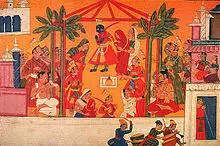| Shrutakirti | |
|---|---|
| Ramayana character | |
 Marriage of Shrutakirti and her 3 sisters | |
| In-universe information | |
| Family | |
| Spouse | Shatrughna |
| Children | Shatrughati, Subahu |
In the Hindu epic Ramayana, Shrutakirti or Shrutakeerti (IAST Śrutakīrti) was a princess and daughter of King Kushadhwaja and Queen Chandrabhaga.[1] She was wife of Shatrughna, younger brother of Rama.
Life
Shrutakirti was the Princess of Sankasya and the younger daughter of King Kushadwaj. She was the incarnation of Mahalaxmi's conch shell. Shrutakirti also had an elder sister Mandavi.[2]
Shrutakirti was married to ayodhya's king Dasharatha's fourth and youngest son Shatrughna. They had two sons, Shatrughati and Subahu.[3]
She used to take care of her in laws, along with her sister Mandavi when her eldest sister Sita and brother in laws Ram and Lakshman was exiled. Later Shrutakirti became queen of Madhupura (Mathura) when her husband Shatrughna captured the capital after killing Lavanasura.[4]
Years later, she died in her sleep along with Urmila and Mandavi.
In popular culture
| Year | TV Series | Channel | Country | Played by |
|---|---|---|---|---|
| 1987–1988 | Ramayan (TV series) | DD National | India | Poonam Shetty |
| 1997-2000 | Jai Hanuman (1997 TV series) | DD Metro | India | Samreen Naaz |
| 2002 | Ramayan (2002 TV series) | Zee TV | India | Malini Kapoor / Aarti Puri |
| 2015–2016 | Siya Ke Ram | Star Plus | India | Tanvi Madhyan |
| 2019–2020 | Ram Siya Ke Luv Kush | Colors TV | India | Nikita Tiwari |
References
- ^ Dawar, Sonalini Chaudhry (2006). Ramayana, the Sacred Epic of Gods and Demons. Om Books International. ISBN 9788187107675.
- ^ Prakāśa, Veda; Guptā, Praśānta (1998). Vālmīkī Rāmāyaṇa. Ḍrīmalaiṇḍa Pablikeśansa. ISBN 978-81-7301-254-9.
- ^ Debroy, Bibek (2005). The History of Puranas. Bharatiya Kala Prakashan. ISBN 978-81-8090-062-4.
- ^ Pargiter, F.E. (1972). Ancient Indian Historical Tradition, Delhi: Motilal Banarsidass, p.170.